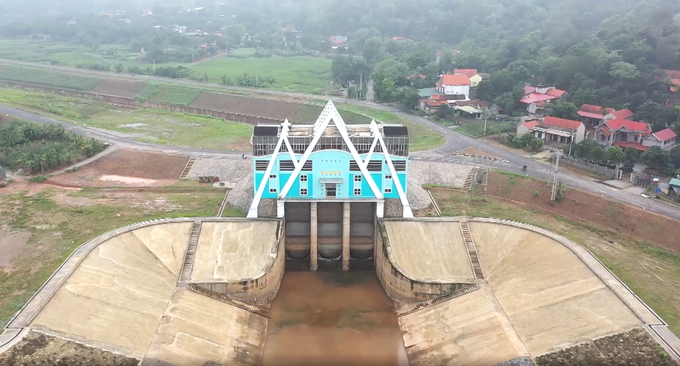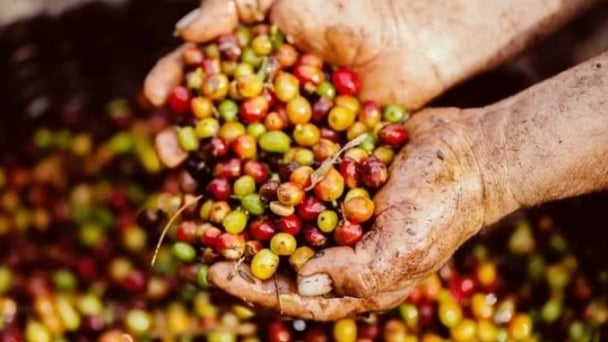June 18, 2025 | 04:47 GMT +7
June 18, 2025 | 04:47 GMT +7
Hotline: 0913.378.918
June 18, 2025 | 04:47 GMT +7
Hotline: 0913.378.918
A review study conducted by three organizations – the Institute of Hydraulic Engineering (under the Vietnam Institute of Water Resources Planning), the Vietnam National Committee on Large Dams and Water Resources Development (VNCOLD), and the Hanoi Mechanics Association – found that Hanoi’s western region has four main rivers: the Tich, Day, Nhue, and To Lich. Since 2002, these rivers have had little to no water flow, leading to stagnation, severe pollution, and a strong, unpleasant odor. This has contaminated groundwater and caused frustration among residents and tourists.
As a result, many local farmers continue using this polluted water to irrigate rice fields, vegetable crops, and even for aquaculture. Over the years, Hanoi has implemented several measures to address the issue, but the results have fallen short of expectations.

Thuan My sluice in Thuan My commune (Ba Vi) is located on the right bank of the Da River, taking water into the Tich River. Photo: Minh Phuc.
The Tich River, stretching 110 km, originates in the Ba Vi mountains and flows through the districts of Ba Vi, Son Tay, Phuc Tho, Thach That, and Quoc Oai. It merges with the Bui River at Tan Truong junction (Thuy Xuan Tien commune, Chuong My district) before joining the Day River at Ba Tha junction.
In recent years, factors such as reservoir construction, deforestation, and climate change have severely depleted the Tich River’s water supply, especially during the dry season. Many sections have essentially become “dead” rivers, disrupting livelihoods and slowing socio-economic development across eight districts in western and southwestern Hanoi.
To address this, in 2010, Hanoi approved a project to restore the Tich River with a total investment of 6.914 trillion VND. The project aimed to divert water from the Da River at a rate of 60m³/s into the Tich River, irrigating 16,000 hectares of farmland while providing water for domestic, agricultural, and industrial use. It also sought to improve the ecological environment, enhance flood drainage, build roads along both riverbanks, and create opportunities for land development to support Hanoi’s socio-economic growth.
Phase 1 of the project was built from 2011 and was expected to complete by 2023. However, according to experts from the Institute of Hydraulic Engineering and VNCOLD, for many years, Hoa Binh Hydropower Reservoir has lacked water. In 2019, the water level was only a third of its design capacity, so the Song Da Water Plant had to install a field pumping station to pump water for treatment.
In the dry season of 2023, the water level of the Da River at Thuan My sluice (Ba Vi district) did not reach +5m, while the designed bottom elevation of the sluice for water intake in the dry season is +5.5m and the designed water level at the sluice is +8.4m. If there is no solution to increase the water level in the dry season, Thuan My sluice will not be able to proactively supply seasonal sources and at many times will be “shelved” like some sluices taking water from the Red River into the Day River and Nhue River.
For the Day River, the Cam Dinh sluice, Hiep Thuan sluice and the 12km long Cam Dinh - Hiep Thuan canal (with the goal of taking water from the Red River, supplying it to the Day River with a dry season flow of 36.24m³/s, and 70m³/s in the flood season, serving production, daily life, improving the ecological environment and restoring the river flow for water transport) were handed over in 2008, but since then, the water level of the Red River at the Cam Dinh sluice has been lower than the sluice bottom elevation (+3m), so there is no water flowing in, and the project is still “shelved.”

Polluted water of the Day River, seen from above. Photo: Minh Phuc.
According to Decision No. 4673/QD-UBND dated October 18, 2012, Hanoi People’s Committee has a plan to renovate and upgrade the connection of two canals, San drainage pumping station and Thuy Duc drainage pumping station, to transfer water from Tich River to supplement Day River with a flow rate of 20m³/s.
However, according to the analysis of experts from the Institute of Hydraulic Engineering and VNCOLD, “in reality it has not been effective,” because from Luong Phu sluice to San pumping station and two canals from San and Thuy Duc pumping stations to Day River, the total length is nearly 70km. Tich River has a large slope, the flow is bent, and there is a lot of loss with the design water level at Luong Phu sluice +8.3m, there will not be enough water to flow into Day River. Therefore, this planning has been around for more than 12 years but it only existed on paper.
For the Nhue River, for many years now, it has been very difficult to get water from the Red River into the Nhue River through the Lien Mac sluice, especially during the period from December of the previous year to January, February, and March of the following year. The reason is that the Lien Mac sluice is designed to get water from the Red River into the Nhue River at an elevation of 3.77m, while the highest water level during water regulation periods from the hydroelectric reservoir, the water level of the Red River, and the Lien Mac sluice section are lower than the sluice's water intake capacity.
The monitoring results were announced by the Department of Environment (Ministry of Natural Resources and Environment) in August 2020, the Nhue River section flowing through Hanoi had 7 points for the water quality index (WQI) at 10-25, meaning heavy to very heavy pollution. The two points of To bridge (Thanh Tri) and Cu Da (Ta Thanh Oai) were the most heavily polluted with an index of 10.
To “revive” the Nhue River, the project to build Lien Mac pumping station with the task of combined irrigation and drainage, with a capacity of 170m³/s to bring water from the Red River and Nhue River, to dilute polluted water, create a flow to wash the Nhue River, and reduce environmental pollution that has formed.
Phase 1 of the project has a capacity of 70m3/s, approved by the Hanoi People’s Committee in Decision No. 1902/QD-UBND dated February 28, 2013, the total investment of this project is 4,242 billion VND, of which the construction cost is 1,716 billion VND, the site clearance cost is 855 billion VND.
At the time of initial approval, the project was scheduled to be implemented between 2013 and 2015, but after more than 10 years, construction has not started. According to irrigation experts from the Institute of Water Resources Planning and VNCOLD, there are many reasons, including technical solutions and post-investment efficiency. If water is pumped to create flow for the Nhue River, it will cost about 1 billion VND in electricity every day and night. Not counting construction costs, management and operation costs and other costs, the investment is large but the efficiency is not certain.
As for To Lich River, the source of water for To Lich River to create flow is West Lake, but West Lake is only a rainwater storage, when there is no rain, the lake must store water according to the design elevation so there is no regular source of water for To Lich River.
The Yen Xa wastewater treatment project, with a capacity of 270m³/day and night, will collect all wastewater discharged into the To Lich and Lu rivers into a pipeline system and then discharge it into the Nhue River. When the project is completed, there will be no more wastewater discharged into the river. At that time, the To Lich, Lu and Set rivers will have no source of supply and will become “dead” rivers.
According to Decision No. 4673/QD-UBND dated October 18, 2012 of Hanoi People's Committee, Lien Mac pumping station will supply 5m3/s to the To Lich River. However, the water level of Lien Mac pumping station's discharge tank when turning back to irrigate is low, it cannot flow back to To Lich River by itself, so it is necessary to pump at 2 levels and invest in many more canals longer than 4km from Nhue River to To Lich River, which is costly and there is no source to supplement water for West Lake.
It can be seen that Hanoi has proposed many plans and projects to revive the inner-city rivers in the West, however, the implemented projects have not yet achieved the expected results and some plans and plans still have many questions about investment efficiency.
Translated by Quynh Chi
![Turning wind and rain into action: [7] Early disaster warnings help marine farmers minimize losses](https://t.ex-cdn.com/nongnghiepmoitruong.vn/608w/files/news/2025/06/17/z6704423696987_15fd32ffc26d590d204d520c9dac6786-nongnghiep-142942.jpg)
(VAN) In recent years, thanks to early disaster warnings and forecasting, marine farmers in Khanh Hoa province have been able to reduce risks and losses, thereby improving production efficiency.
![Turning wind and rain into action: [6] ‘Four on-the-spot’ disaster management software](https://t.ex-cdn.com/nongnghiepmoitruong.vn/608w/files/news/2025/06/17/e5a48259d6a262fc3bb3-nongnghiep-183800.jpg)
(VAN) By simply activating the scenario on the disaster management software, the relevant authorities immediately know how many households need to be evacuated, where to evacuate them to, and by what means of transportation…
![Turning wind and rain into action: [5] Hue applies modern technology in disaster forecasting](https://t.ex-cdn.com/nongnghiepmoitruong.vn/608w/files/news/2025/06/17/z6704423696987_15fd32ffc26d590d204d520c9dac6786-nongnghiep-093938.jpg)
(VAN) In Hue city, modern technology has recently been applied in meteorological and hydrological forecasting and warning, helping to reduce the damage caused by natural disasters.

(VAN) A cutting-edge farming technique being implemented on an experimental ranch in Arizona's Sonoran Desert has already saved a billion gallons of water over five years, according to Civil Eats.

(VAN) Poultry and pig production and the environment can be boosted through enhanced water technology, according to new research.

(VAN) Coffee prices on June 16, 2025 are unchanged. In Vietnam, local trading prices are holding steady, ranging around VND 112,000 – VND 112,500/kg.
![Turning wind and rain into action: [4] Bringing climate bulletins to remote and isolated areas](https://t.ex-cdn.com/nongnghiepmoitruong.vn/608w/files/linhnhp/2025/06/14/1152-z6704423696987_15fd32ffc26d590d204d520c9dac6786-nongnghiep-151141.jpg)
(VAN) The Vietnam Agriculture and Nature Newspaper interviewed Mr. Vu Thai Truong, Acting Head of Climate Change and Environment at UNDP Vietnam, to gain deeper insight into how climate bulletins are delivered to farmers.